Tight butt? Great. Tight abs? Cool. Tight hips? Hell to the nah. If there’s one part of your body you want nice and supple, it’s your hips — you know, that important group of muscles that allows you to run, jump, kick, and hold an unwavering Warrior III pose.
Your hips include several muscles that connect your upper leg to your pelvis and lower back:
- rectus femoris
- iliopsoas
- iliocapsularis
- tensor fasciae latae
- sartorius
- piriformis
Tightness in these muscles can cause noticeable hip pain and stiffness, along with muscular imbalances could even lead to knee and back pain or injuries.
“If you’re experiencing back pain and can’t remember a trauma injury, then chances are your hips are tight,” says Nate Feliciano, owner and head of training at Studio 16 in NYC.
Try these 15 stretches to stay nice and limber.

These stretches can all help relieve tightness in your hips and prevent pain and injury. Pick a few and perform them daily.
Foam roller technique
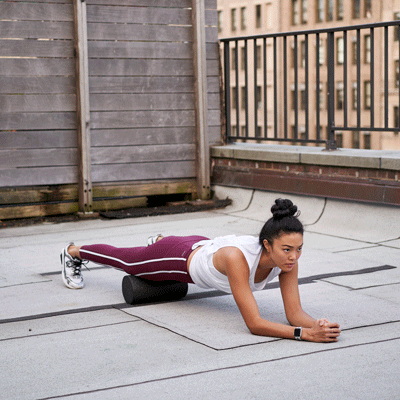
Foam rollers can help you target areas of your hip that might be difficult to access via stretching alone. This foam roller technique targets your hip flexors.
- Start in a position similar to a forearm plank — propped up on forearms with legs stretched out behind you. Grab your foam roller and slide it into place, slightly below where your thighs meet your hips.
- Lower yourself onto the foam roller, placing a bit more of your weight onto right hip than left, while maintaining that forearm plank position.
- Slowly move backward and forward over the foam roller by engaging your core and pivoting back and forth on your toes. For an extra stretch, you can add some side-to-side movement as you roll.
- Identify trigger points, or areas that feel extra tight or painful, and consider giving them some extra attention.
- Continue for up to 30 seconds, then repeat with your left hip.
Horizontal squat stretch

This stretch has major Child’s Pose vibes. In addition to the hips, it also helps loosen up tight back muscles.
- Start with elbows and knees on the floor, knees bent at 90 degrees.
- Walk knees as far apart as you can and lengthen your spine.
- Draw hips back and down, lowering your upper body onto your forearms.
- Hold for up to 60 seconds.
Lunge with spinal twist
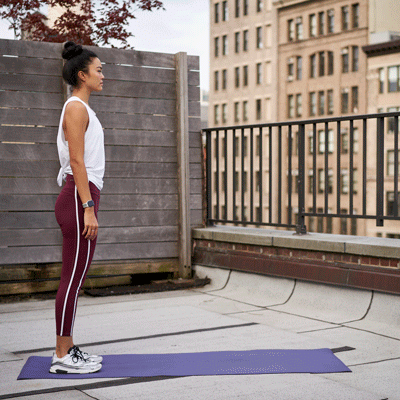
This stretch might also be reminiscent of your last yoga class (hint: yoga is great for your hips!). It targets a stretch of the hip flexors, posteriolateral hips, and quads and promotes a deep spinal twist movement.
- Stand with feet together, then take a big step forward with right foot.
- Bend right knee and lower into a lunge. Keep left leg straight behind you with toes on the floor (you’ll feel a stretch in the front of your left thigh).
- Place left hand on the floor, then twist your upper body to the right as you lift right arm toward the ceiling.
- Hold for at least 30 seconds and up to 2 minutes.
- Repeat on the other side.
Reclined Figure 4 / Pigeon
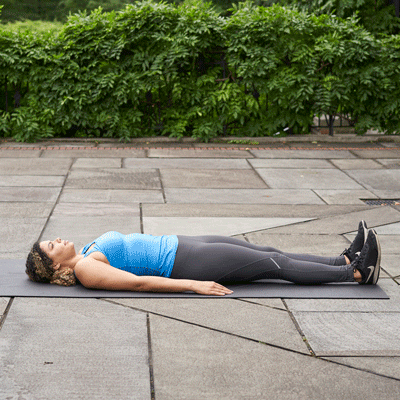
A reclined Figure 4 stretch (sometimes called Reclined Pigeon Pose) is a great way to stretch your piriformis without putting extra pressure on your knees. This stretch targets the hips, lower back, and glutes.
- Lie on your back with knees bent and feet on the floor. Cross left ankle over right thigh, just above knee.
- Hold the back of right leg and slowly draw it toward your chest.
- When you feel a good stretch, hold this position for 3–5 breaths. To deepen the stretch, gently apply pressure.
- Repeat on the other side.
Twisted Reclined Figure 4 / Pigeon
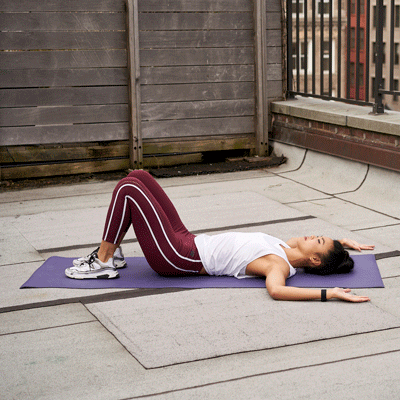
This stretch offers an even gentler way to stretch your hips, lower back, and glutes without putting pressure on your knees or potentially aggravating your upper back.
- Lie on your back with knees bent and feet on the floor. Cross right ankle over left thigh, just above knee.
- Hold the back of left leg and slowly draw it toward your chest.
- Keeping right ankle in place, let legs gently fall to the left. Keep hips square to the ceiling and shoulder blades on the floor.
- Hold for at least 30 seconds and up to 2 minutes.
- Repeat on the other side.
Knee-to-chest stretch
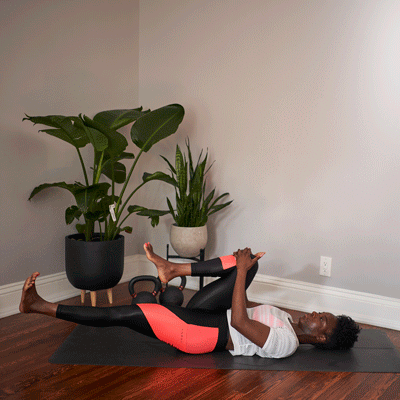
This stretch is similar to the Thomas Test, which trainers and physical therapists often use to assess hip mobility. It’s great at targeting your posterior hips and glutes.
- Lie on your back with legs extended, then bring both knees to your chest.
- While holding right knee to chest, straighten left leg.
- Lower your left leg as far as possible while keeping your lower back pressed into the floor.
- Hold for at least 30 seconds and up to 2 minutes.
- Repeat on the other side.
90/90 stretch
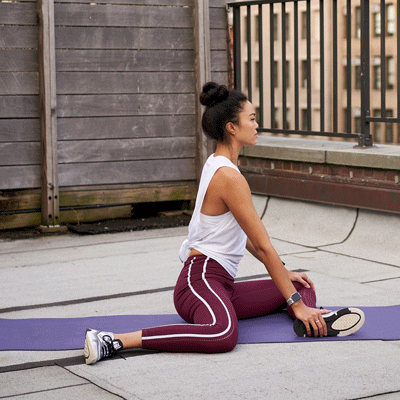
The 90/90 stretch is a great starting point if you want to work your way up to a full Pigeon Pose in yoga but just aren’t there yet. It specifically targets the hips.
- Sit on the floor with left knee bent in front of you at 90 degrees. Your calf should lie horizontally in front of your body, and your foot should remain flexed.
- Place right knee to the right of your body and bend the knee so your foot faces behind you. Keep left glute on the floor and try to move right glute as close to the floor as possible without causing pain.
- Hold for at least 30 seconds and up to 2 minutes.
- Repeat on the other side.
Reclined Bound Angle Pose
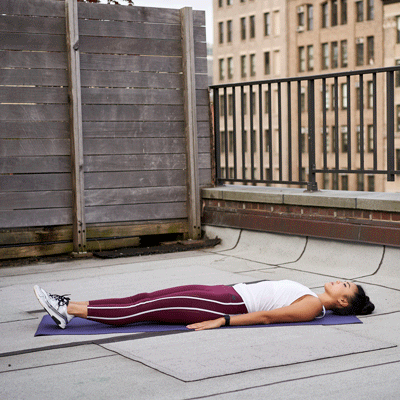
This ultra-relaxing stretch pairs well with some deep belly breaths during your lunch break. It targets your hips, groin, and inner thighs.
- Lie on your back. Bring soles of feet together and let knees open and move toward the floor until they reach their natural stopping point.
- Hold for at least 30 seconds and up to 2 minutes.
Piriformis stretch
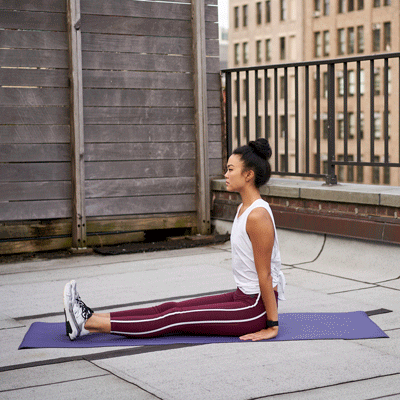
Anyone else remember this stretch from high school soccer practice?! This simple yet effective move stretches your hips, glutes, and lower back.
- Sit on the floor with legs extended in front of you.
- Cross left leg over right leg, placing left foot flat on the floor. Place left hand on the floor behind you.
- Place right elbow on the outside of left knee. Keeping left thigh steady, use right elbow for leverage to twist your torso to the left.
- Hold for at least 30 seconds and up to 2 minutes.
- Repeat on the other side.
Three-Legged Dog
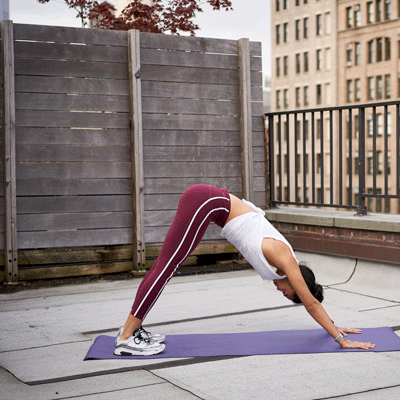
More yoga vibes! This spin on a Downward Dog simultaneously stretches one hip while building strength in the other. This stretch targets your hips, back, hamstrings, and shoulder muscles.
- Start in a Downward Dog position.
- Lift one leg off the floor and extend it high behind you, keeping knee as straight as possible. To target different muscles, you can point or flex your toes.
- Hold for up to 30 seconds.
- Repeat with the other leg.
Kneeling side bend stretch
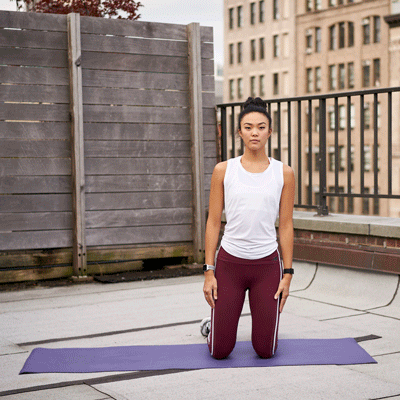
Simple yet effective, the kneeling side bend stretches your hips, inner thighs, groin, and abdominals. Use a mat to prevent knee pain.
- Kneel on a mat with your legs together. Keep core tight and back straight.
- Extend right leg to the side (perpendicular to your body). Extend left arm toward the ceiling and rest right arm on right leg.
- Slowly lean left arm and torso to the right until you feel a stretch. Your hips should remain facing forward.
- Hold for at least 30 seconds and up to 2 minutes.
- Repeat on the other side.
Kneeling hip flexor stretch
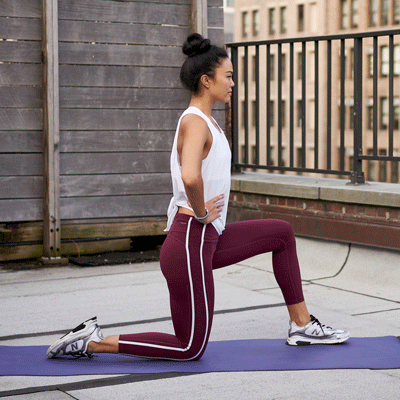
This stretch is a simple but effective way to gently stretch the tightest of hip flexors. Just grab a yoga mat to protect your knees.
- Kneel on a mat. Place right foot forward on the floor so you have a 90-degree angle at your hip and knee.
- Squeeze glutes and engage core, which will create an upward tilt in your pelvis and provide a light stretch in your left hip.
- Hold for up to 30 seconds.
- Repeat on the other side.
Lunging hip flexor stretch
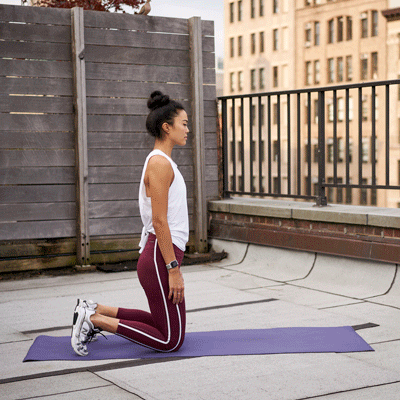
This is basically a continuation of the kneeling hip flexor stretch, offering a deeper stretch. It’s one of Feliciano’s favorites, targeting the hip flexors and quads.
- Kneel on a mat. Place right foot forward on the floor so you have a 90-degree angle at your hip and knee.
- Squeeze glutes and engage core, which will create an upward tilt in your pelvis.
- Slowly drive left hip forward while keeping torso straight.
- Hold for up to 30 seconds.
- Repeat on the other side, trying to increase your stretch each time.
Lunging hip flexor stretch with rotation
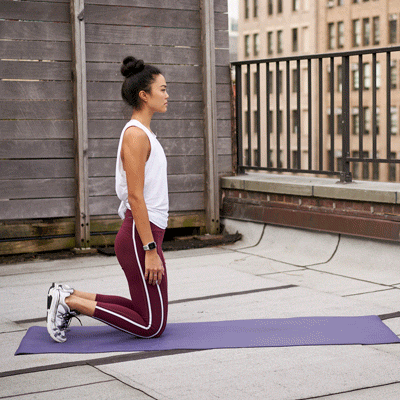
This version of the hip flexor stretch provides a particularly deep stretch and allows you to target areas of your hips that might otherwise seem out of reach. It targets the hip flexors, glutes, and quads.
- Kneel on a mat. Place right foot forward on the floor so you have a 90-degree angle at your hip and knee.
- Squeeze glutes and engage core, which will create an upward tilt in your pelvis.
- Slowly drive left hip forward while keeping torso straight.
- Rotate your torso open to the left, reach hands down to the floor, and keep chest elevated.
- Hold for at least 30 seconds and up to 2 minutes.
- Repeat on the other side.
Pretzel stretch
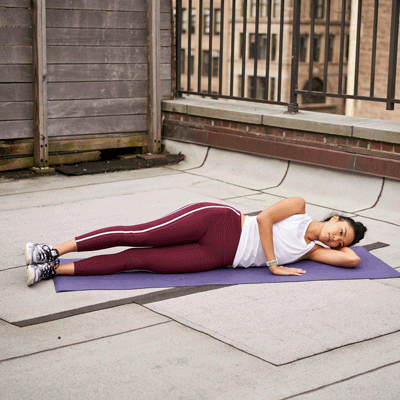
This stretch provides a safe, gentle way to get a nice deep stretch in the front of your thigh. It targets your hips, quads, back, glutes, and abdominals.
- Lie on your left side, resting your head on left arm. Bend right knee and move it up toward your chest, then allow it to rest on the floor.
- Bend left knee, grabbing left foot with right hand. (Not possible? Try using a yoga strap.) Keep left leg and torso in a straight line as you hold the stretch.
- For a gentle spinal twist, bring right shoulder blade toward the floor, turning your head to the right for a deeper twist.
- Hold for at least 30 seconds and up to 2 minutes.
Hip stiffness and soreness, particularly where the top of your thigh meets your pelvic bone, is often a sign of tight hips. Pain in your lower back, knees, glutes, or hamstrings could be an indicator too.
But pain isn’t always present with tight hips, especially in the beginning. So if you’re unsure, check at home. According to Feliciano, one simple way to know is by performing a modified version of the Thomas Test:
- Lie on your back with legs extended.
- Bring both knees to your chest.
- While holding right knee to chest, straighten left leg.
- While holding right knee to chest, straighten left leg as much as possible
- Repeat with your other leg.
“If your left leg isn’t able to completely straighten on the floor, or if you feel a pull in your hip, then that is a sign of tightness in your hips,” says Feliciano.
Too much sitting puts your hip flexors (particularly the iliopsoas) into a shortened position for much longer than they should be, which can be a big contributor to hip tightness. And we definitely do a lot of sitting — the average U.S. adult sits for 6.4 hours a day.
This can reduce your mobility and mess with your ideal body mechanics, setting you up for pain and injury. For example, too much sitting can lead to anterior pelvic tilt (when the front of the pelvis rotates forward and the back of the pelvis rises), which often leads to tightness in the hip flexors and weakness in the glutes.
But it’s not just a sedentary or minimally active lifestyle that causes tight hips. According to Feliciano, certain types of exercise can also contribute if you’re not stretching adequately.
For example, runners are constantly shortening and contracting their hip flexors to lift their legs with each stride, but this isn’t countered with an equal lengthening movement. And cyclists are positioned in a forward-leaning position in which hip muscles are almost always shortened.
It’s hard to avoid all the things in life that can contribute to tight hips (and you don’t always want to — after all, running and cycling are great forms of exercise!). But you can take simple steps to keep those hip flexors supple and reduce your risk of pain and injury:
- Stretch every day. “Ideal frequency of stretching will vary depending on muscle imbalances and lifestyle,” says Feliciano. “However, on average, I recommend most of my clients stretch in the morning and periodically throughout the day, especially if they spend most of their day seated.”
- Try a standing desk. Standing puts your hip flexors in an extended position that helps counteract the effects of sitting.
- Get up and move every hour. Even better than a standing desk, try to incorporate mini movement breaks every hour or so, even if it’s just walking downstairs to get another cup of tea or doing 10 squat jumps. This will help prevent tightness and build strength. Bonus: Research suggests these movement breaks can promote longevity.
- Book yourself a massage. For really tight hips that you can’t adequately stretch on your own (which may occur if you’re an avid runner, cyclist, or CrossFit enthusiast), consider booking a massage. Even better if it’s with a sports massage therapist or a physical therapist who can specifically target imbalances and work on hip mobility issues caused by exercise that might otherwise lead to injury.
Whether you’re an athlete or a desk jockey, chances are pretty high that you have tight hips — especially if you’re not regularly stretching or moving your body in a way that counters hip flexor shortening. This can lead to significant pain in your hips, lower back, and knees and set you up for serious injury over time.
To assess just how tight your hips are, do the Thomas Test recommended by Feliciano, and then incorporate the stretches above into your daily routine.
Bottom line: Your hips don’t lie (thanks, Shakira), so take any tightness and discomfort seriously.

